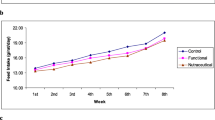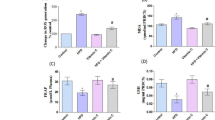Abstract
Rats fed with hypercholesterolemic diet showed a significant increase in serum total—cholesterol, liver homogenate total-cholesterol, HDL-cholesterol and changed LDL-cholesterol, and HDL/LDL ratio in comparison to control. Flaxseedchutney (FC) supplemented diet (15%, w/w) was found to be more effective in restoring lipid profile changes in rats fed with cholesterol, (1.0%). The activities of serum marker enzymes glutamate oxaloacetate transminase (GOT), glutamate pyruvate transaminase (GPT) and alkaline phosphatase (ALP) were elevated significantly in carbon tetrachloride induced rats. Administration of flaxseedchutney (15%, w/w) resulted in depletion of serum marker enzymes and exhibited recoupment thus showing significant hepatoprotective effect. It was observed that flaxseedchutney supplemented diet could lower the serum cholesterol and as a potential source of antioxidants it could exert protection against hepatotoxic damage induced by carbon tetrachloride (CCl4) in rats.
Similar content being viewed by others
References
Cunnane SC, Thompson LU, editors. Flaxseed in human nutrition. Champagn (IL): USA: AOCS Press; 1995.
Thompson LU, Rickard SE, Cheung F, Kenaschuk EO, Obermeyer WR. Variability in anticancer lignan levels in flaxseed. Nutrition and Cancer 1997; 27: 26–30.
Madhusudhan B, Wiesenborn D, Schwarz J, Tostenson K, Gillespie J. A dry mechanical method for concentrating the lignan secoisolariciresinol diglucoside in flaxseed. Lebensm.-Wiss. U-Technol 2000; 33: 268–75.
Weisenborn DP. Lignan concentrate from flaxseed. News Letter 1999, Agri Biosys Engg Dept, NDSU, Fargo, USA.
Prasad K. Purified SDG as an antioxidant. U.S: Patent, 5846944: 1998.
Cunnane SC, Ganguli S, Menard C, Lilde AC, Hamadeh MJ, Chen Z-Y, Wolever TMS, Jenkins DJA. High alpha-linolenic acid and flaxseed (Linum usitatissimum): Some nutritional properties in humans. Brit J of Nutr 1993; 69: 443–53.
Ohkawa H, Ohishi N, Yagi K. Assay for lipid peroxides in animal tissues by thiobarbituric acid reaction. Anal Biochem 1979; 95: 351–58.
Folch J, Lees M, Sloano-Stanley GH. A simple method for the isolation and purification of total lipids from animal tissues. J Biol Chem 1957; 226: 497–509.
Zelkis A, Zak B. Study of a new cholesterol reagent. Anal Biochem 1969; 29: 143–47.
Reitman S, Frankel S. A colorimetric method for the determination of serum glutamic oxalacetic and glutamic pyruvic transaminases. Am J Clin Pathol. 1957; 28(1): 56–63.
Malloy, Helga Tait; Evelyn, Kenneth A.: The determination of bilirubin with the photoelectric colorimeter. J Biol Chem 1937; 119: 481–90.
Lowry oh, Rosebrough NJ, Farr al, randall rj. Protein measurement with the Folin phenol reagent. J Biol Chem 1951; 193: 265–75.
Jones PH. Clinical diagnosis of lipid disorders. Clin Cornerstone 1998; 1(1): 15–30.
Mabuchi H, Koizumi J, Shimizu M, Kajinami K, Miyamoto S, Ueda K, Takegoshi T: Long-term efficacy of low-density lipoprotein apheresis on coronary heart disease in familial hypercholesterolemia. Hokuriku-FH-LDL-Apheresis Study Group.Am J Cardiol 1998; 82: 1489–1495.
Bonnefont-Rousselot D, Therond P, Beaudeux JX, Peynet J, legrand A, Delattre. High density lipoproteins (HDL) and the oxidative hypothesis of atherosclerosis. Clin Chem Lab Med 1999; 37(10): 939–948
Augusti KT, Anuradha, Prabha SP, Smitha SB, Sudhesh M, Anu George, Joseph MC. Nutraceutical effects of garlic oil, its nonpolar fraction and a ficus flavonoid as compared to vitamin E in CCI4 induced liver damage in rats. Ind J Exp Biol 2005; 436: 437–44.
Recknagel RO, Glende EA Jr: Carbon tetra- chloride hepatotoxicity: an Example of lethal cleavage. CRC Crit Rev Toxicol 1973; 2: 263–297.
Tomoyuki K, Ritsu C, Daisuke U, Kohji Y, Kazunaga Y. Hepatoprotective Effect of a Hot-Water Extract from the Edible Thorny OysterSpondylus varius on Carbon Tetrachloride-Induced Liver Injury in Mice. Biosci Biotechnol Biochem 2006; 70 (3): 729–731.
Pohl LR, Schulick RD, Highet RJ, George JW. Reductive-oxygenation mechanism of metabolism of carbon tetrachloride to phosgene by cytochrome P-450. Molecular Pharmacology, 1984; 25:318–321
McCay PB, Lai EK, Poyer JL, DuBose CM, Janzen EG. Oxygen- and carbon-centered free radical formation during carbon tetrachloride metabolism:Observation of lipid radicals in vivo and in vitro. J Biol Chem. 1984; 259(4): 2135–43.
Lim HK, Kim HS, Choi HS, Oh S, Choi J. Hepatoprotective effects of bergenin, a major constituent of Mallotus japonicus, on carbon tetrachloride-intoxicated rats. J Ethnopharmacol. 2000; 72(3):469–74.
Kadiiska MB, Gladen BC, Baird DD, Dikalova AE, Sohal RS, Hatch GE, Jones DP, Mason RP, Barrett JC. Biomarkers of oxidative stress study: are plasma antioxidants markers of CCI(4) poisoning? Free Radic Biol Med. 2000; 28(6):838–45.
Author information
Authors and Affiliations
Corresponding author
Rights and permissions
About this article
Cite this article
Shakir, K.A.F., Madhusudhan, B. Hypocholesterolemic and hepatoprotective effects of flaxseed chutney: Evidence from animal studies. Indian J Clin Biochem 22, 117–121 (2007). https://doi.org/10.1007/BF02912893
Issue Date:
DOI: https://doi.org/10.1007/BF02912893




